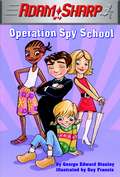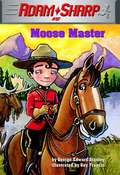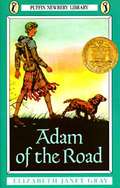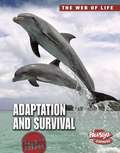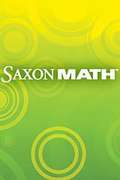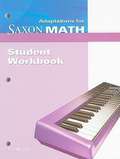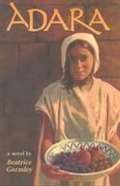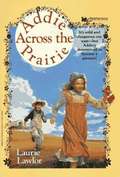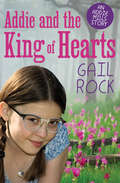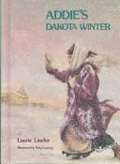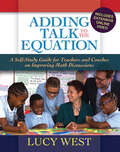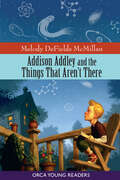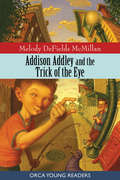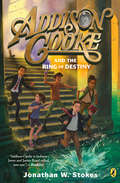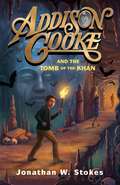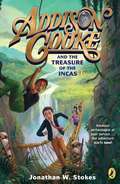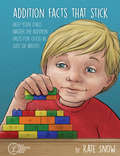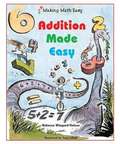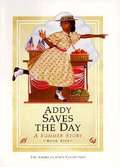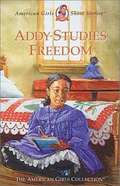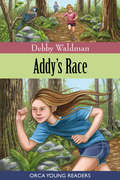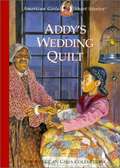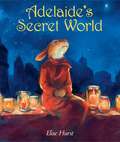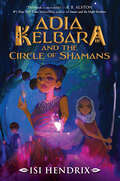- Table View
- List View
Adam Sharp #4: Operation Spy School (Adam Sharp #4)
by George Edward Stanley Guy FrancisIt's reading, writing, and reconnaissance for Adam Sharp and the other IM-8 agents when they go back to spy school. But even the hallowed halls of learning aren't safe from evil. Someone is leaking IM-8 secrets! Could there be a spy at spy school? Only Adam Sharp can find out!
Adam Sharp #5: Moose Master (Adam Sharp #5)
by George Edward Stanley Guy FrancisTimber! It's off with the tuxedo and on with a red jacket when Adam Sharp goes undercover as a Mountie in Canada's north woods. Ecanem, a mysterious logging company, is hogging Canada's lumber business, so the Mounties call on superspy Adam Sharp to get to the bottom of things. Will this wanabee Mountie get his man--or, in this case, will he only get a moose?
Adam of the Road (Newbery Library Puffin Series)
by Elizabeth Janet GrayAwarded the John Newbery Medal as "the most distinguished contribution to American literature for children" in the year of its publication. "A road's a kind of holy thing," said Roger the Minstrel to his son, Adam. "That's why it's a good work to keep a road in repair, like giving alms to the poor or tending the sick. It's open to the sun and wind and rain. It brings all kinds of people and all parts of England together. And it's home to a minstrel, even though he may happen to be sleeping in a castle." And Adam, though only eleven, was to remember his father's words when his beloved dog, Nick, was stolen and Roger had disappeared and he found himself traveling alone along these same great roads, searching the fairs and market towns for his father and his dog. Here is a story of thirteenth-century England, so absorbing and lively that for all its authenticity it scarcely seems "historical." Although crammed with odd facts and lore about that time when "longen folke to goon on pilgrimages," its scraps of song and hymn and jongleur's tale of the period seem as new minted and fresh as the day they were devised, and Adam is a real boy inside his gay striped surcoat.
Adaptation and Survival
by Robert SneddenThe book explains how living things develop features to adapt themselves to their environment, improve their chances of survival and also about the natural selection process.
Adaptations for Saxon Math Student Reference Guide Intermediate 3-5
by Pat WrigleyNIMAC-sourced textbook
Adara
by Beatrice Gormley"The soldier heaved me over his shoulder as if I were a spring lamb. I am not Israelite!" I screamed, beat his back, hurting my hands. "Let me go." Adara has always longed to do the things that well-brought-up girls of her time are not supposed to do. She wants to learn to read and write -- like men. And she wants the freedom to travel -- like men -- outside the boundaries of her sheltered life. One day she awakens to a blast of trumpets as the Israelites and Arameans battle just outside the safety of her village walls. Curious, Adara sneaks out to see the battle. Little does she know that this will be her last day of freedom for a very long time. Sold into slavery, Adara becomes a servant to General Namaan and his family and begins a remarkable journey of self-discovery, healing, and redemption -- a journey that, in the end, faces her with the hardest decision of her life.
Addie Across the Prairie (Addie, Book #1)
by Laurie LawlorAddie's family is traveling by wagon to homestead on the vast Dakota Territory, and Addie soon learns that she has the pioneer spirit.
Addie and the King Of Hearts
by Gail Rock[From the Back cover:] "Thirteen-year-old Addie Mills has special feelings for her new teacher, Mr. Davenport. Her immature friends don't understand her feelings, but Addie knows this is more than just a schoolgirl crush. Addie's sure her classmate Billy Wild will invite her to the Valentine's Dance, and she can't understand it when he asks another girl. Then Addie decides Billy's too young for her anyway, especially since Mr. Davenport has promised to tell her something special at the dance. Then, on that magical night, Mr. Davenport's news takes Addie by surprise. Why does love have to be so confusing?" The three other books about Addie by Gail Rock are in the Bookshare collection. Look for The House Without A Christmas Tree, The Thanksgiving Treasure and A Dream for Addie.
Addie and the King of Hearts (The Addie Mills Stories #4)
by Gail RockIn 1949 a special Valentine&’s Day dance in small-town Nebraska teaches thirteen-year-old Addie about real love Kids in Addie&’s seventh-grade class are starting to exchange rings and go steady, but Addie hates all that mush. When she grows up, she plans to be a real artist in New York City and never get married. Addie&’s best friend is Carla Mae Carter, whose family lives next door. Addie&’s worst friend, for as long as she can remember, has been annoying Tanya Smithers, who plans on becoming a ballet dancer. She&’s always twirling around or striking a dramatic pose to remind everyone how talented she is. Addie definitely does not have a crush on Billy Wild, even if he is tall and cute and has dark, curly hair and blue eyes. She&’s way too busy with her art for such silliness. Anyway, Tanya likes Billy—and they can have each other as far as Addie is concerned. But after Christmas break, the seventh-grade class gets a new teacher, Mr. Davenport, who has movie-star looks and studied art in college and even takes a special interest in Addie&’s paintings. Addie starts to notice a strange feeling in her stomach when she&’s around the handsome young teacher. Is this what love feels like? Is this what all the other girls have been giggling about? Addie suddenly starts to care about wearing dresses instead of jeans and getting her hairstyle just right. Will Addie get her moment with Mr. Davenport at the Valentine&’s Day dance? Or will her true king of hearts be someone in her class—someone she never expected?
Addie's Dakota Winter (Addie, Book #2)
by Laurie LawlorAddie knew she had been a coward and a liar. Those awful boys were going to break Tilla's arms, and it was all Addie's fault. Would Tilla ever forgive her? In 1883, Addie Mills and her family traveled to Dakota and began a new way of life. Now school is starting, and more than anything, Addie wants a best friend. But how can she be friends with Tilla Bergstrom who is loud and rude and makes up stories? Some bullies, a blizzard, and a terrible loss help Addie understand the real meaning of friendship. Readers will also enjoy ADDIE ACROSS THE PRAIRIE, by Laurie Lawlor, which tells about Addie's first months as a Dakota pioneer.
Adding Talk To The Equation: A Self-Study Guide for Teachers and Coaches on Improving Math Discussions
by Lucy WestFor more than 20 years, Lucy West has been studying mathematical classroom discourse. She believes that teachers need to understand what their students are thinking as they grapple with rich mathematical tasks and that the best way to do so is through talking and listening. In this video-rich edition of Adding Talk to the Equation: Discussions and Discovery in Mathematics, she invites teachers into real-life classrooms where all students stay in the game, stay motivated about learning, and ultimately deepen their understanding. Designed for math teachers and coaches in grades 18, this self-study guide showcases elementary and middle school classrooms where teachers inspire even the most reluctant students to share their ideas. Through the stories of skilled teachers, West offers play-by-play commentary as they get more comfortable with new talk moves and learn to tune in and respond to students' math conversations. Although these discussions occur in math class, the strategies can be used to create a respectful, productive environment for any subject area. This video-based resource examines the importance of creating a safe learning environment; the value of thinking, reasoning, and questioning; the role of active, accountable listening; and the necessity of giving all students a you can do this message. West also emphasizes that slowing down, even in the face of time constraints, is crucial for creating a classroom where all students feel they have something to contribute. This guide includes transcripts of the case studies, with insightful commentary from West that gives you a window into her thinking and the complexities of the work she is doing with teachers, as well as her reflections on missed opportunities.
Addison Addley and the Things That Aren't There (Orca Young Readers)
by Melody DeFields McMillanAddison Addley hates math. He hates public speaking too. Actually, he hates anything that involves work, but he only has a couple of weeks to write and memorize his grade five speech. The problem is, he can't think of a single topic. When he finally comes up with an excellent idea for a speech, it almost writes itself, but it's his poor math skills that make speech day unforgettable.
Addison Addley and the Trick of the Eye (Orca Young Readers)
by Melody Defields McmillianAddison's mother wants to sell their comfortable old house and move into a townhouse in a new development across town - a shoe box near a shoe factory, Addison calls it. As usual, Addison's brain goes into overdrive as he tries to solve two problems: first he must get his mother to see their old house in a new light, and then he must figure out who is responsible for a rash of neighborhood break-ins that make his mother feel unsafe. With the help of his friend Sam, he puts his own unique spin on optical illusions (and home decor) and ends up surprising everyone, even himself.
Addison Cooke and the Ring of Destiny (Addison Cooke #3)
by Jonathan W. StokesIn the tradition of Indiana Jones and The Goonies, the next installment of this comedic adventure series sends young Addison and his friends on the run from fortune hunters linked to an ancient Cooke clan curse.Soon after the disappearance of his aunt Delia and uncle Nigel outside the tomb of notorious Mongolian leader Genghis Khan, amateur archeologist Addison Cooke, his sister Molly, and their best friends Raj and Eddie, embark on another globe-trotting adventure. When a mysterious package arrives on Addison's doorstep, criminals and fortune-hunters from around the world are suddenly hunting the Cooke family. Addison and team will travel to London, Paris, Istanbul, and beyond, on the run for their lives to unravel the mystery of the package, find out what really happened to Aunt Delia and Uncle Nigel, and come face-to-face with the terrifying Vrolock Malazar. But Addison and the team find there are dangerous secrets about his aunt and uncle's pasts and hidden truths about the Cooke clan that must be uncovered.Addison Cooke and the Ring of Destiny is full of nonstop laughs and heart-pounding action, perfect for fans of James Patterson's Treasure Hunters series, Rick Riordan's Percy Jackson series, and Peter Lerangis's Seven Wonders series.
Addison Cooke and the Tomb of the Khan (Addison Cooke)
by Jonathan W. Stokes"Addison Cooke is Indiana Jones and James Bond rolled into one for the middle-grades set."--BooklistAddison Cooke's second laugh-out-loud adventure--a journey through Asia in pursuit of the legendary tomb of Genghis Khan!Fresh off of a victorious treasure hunt and rescue mission in South America, Addison Cooke just can't seem to steer clear of rogue bandits, pesky booby traps, and secret treasure troves. But it sure beats sitting around in school all day.Addison's aunt and uncle, on the other hand, are none too happy about their habit of attracting kidnappers. When they become pawns in a dangerous gang's plan to steal the most prized possession of the notorious Mongolian leader Genghis Khan, Addison and his friends find themselves once again caught in the middle of a multi-million-dollar international heist. Armed with nothing but their wits and thirst for adventure, they travel across Asia in an attempt to rescue Addison's family and stop the treasure from falling into the wrong hands.Brimming with round-the-clock action and tons of laughter, Addison Cooke and the Tomb of the Khan is perfect for fans of Indiana Jones, ancient history, and James Patterson’s Treasure Hunters series.Praise for Addison Cooke and the Treasure of the Incas:"Combines the derring-do of Indiana Jones with a genuine archaeological mystery. Stokes brings a cinematic scope to the story. This lively debut promises more seat-of-the-pants thrillsfor readers who love adventure."--Booklist"Cinematic pacing and action drive the story, but it’s Addison and his friends who will keep readers engaged. Humor is never in short supply . . . and Addison’s endless optimism and irrepressible confidence in his own abilities are endearing."--School Library Journal"Addison is often one step ahead of the adults, but his lead is constantly threatened, building steady tension throughout the novel, screenwriter Stokes’s debut."--Publishers Weekly
Addison Cooke and the Treasure of the Incas
by Jonathan W. StokesThe Goonies meets Indiana Jones and James Patterson's Treasure Hunters in this funny, action-filled adventure series! Twelve-year-old Addison Cooke just wishes something exciting would happen to him. His aunt and uncle, both world-famous researchers, travel to the ends of the earth searching for hidden treasure, dodging dangerous robbers along the way, while Addison is stuck in school all day. Luckily for Addison, adventure has a way of finding the Cookes. After his uncle unearths the first ancient Incan clue needed to find a vast trove of lost treasure, he is kidnapped by members of a shadowy organization intent on stealing the riches. Addison's uncle is the bandits' key to deciphering the ancient clues and looting the treasure . . . unless Addison and his friends can outsmart the kidnappers and crack the code first. So it's off to South America, where the excitement, danger, gold, booby traps, and car chases are never-ending! Full of laugh-out-loud moments and nonstop action, and perfect for fans of Indiana Jones or James Patterson's Treasure Hunters series, Addison Cooke and the Treasure of the Incas is sure to strike gold with kid readers.Praise for Addison Cooke and the Treasure of the Incas"Cinematic pacing and action drive the story, but it's Addison and his friends who will keep readers engaged. Humor is never in short supply, even when the group narrowly escapes danger, and Addison's endless optimism and irrepressible confidence in his own abilities are endearing . . . A solid start to a new series, with a conclusion that will leave readers hoping Addison and company return soon for another adventure."--School Library Journal"Addison is often one step ahead of the adults, but his lead is constantly threatened, building steady tension throughout the novel, screenwriter Stokes's debut."--Publishers Weekly From the Hardcover edition.
Addition Facts that Stick: Help Your Child Master the Addition Facts for Good in Just Six Weeks
by Corrin Brewer Debra Pearson Kate SnowThe fun, engaging program that will help your child master the addition facts once and for all—without spending hours and hours drilling flash cards! Addition Facts That Stick will guide you, step-by- step, as you teach your child to understand and memorize the addition facts, from 1 + 1 through 9 + 9. Hands-on activities, fun games your child will love, and simple practice pages help young students remember the addition facts for good. In 15 minutes per day (perfect for after school, or as a supplement to a homeschool math curriculum) any child can master the addition facts, gain a greater understanding of how math works, and develop greater confidence, in just six weeks! Mastery of the math facts is the foundation for all future math learning. Lay that foundation now, and make it solid, with Addition Facts That Stick!
Addition Made Easy (Making Math Easy)
by Rebecca Wingard-Nelson Tom LaBaffAre you having trouble with two-digit addition? How about three-digit addition? Does column addition confuse you? Do you wish someone could simply explain the properties of addition? Well, ask no more! In a simple and direct style, Rebecca Wingard-Nelson covers topics such as partial sums, regrouping, and place value. Whether you are learning this information for the first time—on your own or with a tutor—or you would like to review your math skills, this book will be a great choice.
Addy Saves the Day: A Summer Story Book (An American Girl #5)
by Connie PorterIt's summer in Philadelphia. The Civil War has ended, and families like Addy's that have been separated are searching for their loved ones. The church is putting on a fund-raising fair to help people hurt by the war. <P><P>When Addy has to work on the fair with her snobby friend Harriet, their feud heats up again-until tragedy forces the girls to soften their hearts. The fair is a great success. Then, suddenly, they discover that the money they've raised has been stolen. Addy saves the day and is rewarded with a wonderful surprise.
Addy Studies Freedom (American Girls Short Stories #22)
by Connie PorterIn addition to a heartwarming story set in Civil War times, this book includes fun historical facts related to Abraham Lincoln. How many blocks make up the Lincoln Memorial? (Other American Girl books are also available from Bookshare.) This file should make an excellent embossed braille copy.
Addy's Race
by Debby WaldmanAddy has worn hearing aids for as long as she can remember. Her mother tells her this makes her special, but now that Addy's in grade six, she'd wants to be special for what she's done. When Addy joins the school running club to keep her best friend, Lucy, company, she discovers she is a gifted runner. Lucy isn't, which is problematic. Further troubles surface when Addy gets paired on a school project with Sierra, a smart, self-assured new classmate who wears a cochlear implant. Addy is surprised to discover hearing loss is all they have in common-and a shared disability is not enough of a foundation for a friendship. True friends support each other, even if they have different passions and dreams. More importantly, Addy comes to understand that she is defined by more than her hearing loss. She has the power to choose how people will see her, and she does.
Addy's Wedding Quilt (American Girls Short Stories #16)
by Connie PorterThough her parents "Jumped the broom," to get married when they were slaves, now that they are living free in Philadelphia after the Civil War they plan to have a church wedding and Addy works to complete a special quilt to give them as a wedding gift.
Adelaide's Secret World
by Elise HurstA gorgeously illustrated picture book about creativity, making connections, and finding friendship. Sure to appeal to fans of Shaun Tan or Aaron Becker.With a poetic story and lush paintings, Elise Hurst conveys how a bit of bravery, empathy, and imagination can transform our lives.Adelaide lives in a city filled with people and wonders, but she is lonely. She is a watcher, and she sees others like her: the quiet ones, those who dance and dream alone. In a chance encounter, Adelaide meets someone who just might be a kindred spirit--and is so startled and shy she runs away! But then she gathers her courage and uses all her ingenuity to make sure that they--and all the other lonely ones--meet and connect and share their dreams.
Adia Kelbara and the Circle of Shamans (Adia Kelbara and the Circle of Shamans)
by Isi HendrixThe first book in a fast-paced, witty, and big-hearted debut Afrofantasy trilogy about a twelve-year-old apprenticing in the kitchens at the prestigious Academy of Shamans, who must ally with a snarky goddess and a knife-wielding warrior to save her kingdom. Perfect for fans of Amari and the Night Brothers and The School for Good and Evil.Life is tough for twelve-year-old orphan Adia. Her aunt and uncle believe she’s an ogbanje, a demon-possessed child that brings misfortune wherever they go, and Adia can’t disagree—especially when she suddenly manifests mysterious powers that she can’t control, causing an earthquake in her village.So when Adia is offered a kitchen apprenticeship at the faraway Academy of Shamans, she flees with nothing but a pouch of change, her cat Bubbles, and the hope that someone there can figure out what's wrong with her—and fix it. But just as she's settling in, Adia stumbles upon a shocking secret: Unlike her, the kingdom's emperor really is possessed—by a demon more wicked than any other. And he’s on his way to the Academy for a visit.Joining forces with a snarky goddess, a 500-year-old warrior girl, and an annoying soldier-in-training, Adia must travel through hidden realms to exorcise the emperor and save her kingdom. But to succeed, she first must come to understand the powers inside her….The fate of the world hangs in the balance.
